Condition Monitoring for Roller Bearings of Wind Turbines Based on Health Evaluation under Variable Operating States
Abstract
:1. Introduction
2. Review of Condition Monitoring Theory
2.1. Rolling Bearing Kinematics
2.2. Wavelet Packet Decomposition
2.3. Variational Mode Decomposition
2.4. Renyi Entropy
3. Proposed Method
3.1. Experimental Setup
3.2. Health Evaluation Using VMD Renyi Entropy
4. Experiment and Discussion of Results
4.1. Experimental Description
4.2. Basic Analysis Characteristics
4.3. Decomposition and Health Evaluation
5. Discussion
6. Conclusions
- (1)
- Frequency-domain amplitude of the vibrational signal is not only dependent on the health state of the bearings, but also relies on the operational conditions such as rotation torque and speed.
- (2)
- The evaluation of the probability distribution for the vibrational signal is more efficient than the time and frequency analyses, particularly for fluctuating operating conditions.
- (3)
- The improved evaluation algorithm based on the VMD Renyi entropy may decrease the impact of the fluctuating operating conditions and permit the identification of the real state of the bearing more effectively. The maximum error caused by the variable conditions was relatively small when compared to wavelet packet decomposition. Thus, the reliability of the CM result was significantly enhanced.
Acknowledgments
Author Contributions
Conflicts of Interest
Appendix A
| Specifications | Value |
|---|---|
| Torque range | ±20 Nm |
| Impulse frequency at zero point (torque) | 0 kHz |
| Impulse frequency at positive maximum scale point (torque) | 15 kHz |
| Impulse frequency at negative maximum scale point (torque) | 5 kHz |
| Rotation speed range | 5000 rpm |
| Encoder resolution | 1024 pulse/r |
| Specifications | Value |
|---|---|
| Acceleration range | 50 g |
| Sensitivity | 96.7 mV/g |
| Frequency response range | 0.5 Hz–5 kHz |
| Constant current source supply | 2 mA |
| Specifications | Value |
|---|---|
| Bearing type | 32,206 |
| Manufacturer | SKF, Goteborg, Sweden |
| Inner diameter | 30 mm |
| Outer diameter | 62 mm |
| Contact angle | 14° |
| Rolling element equivalent diameter | 8.5 mm |
References
- Pan, M.C.; Li, P.C.; Cheng, Y.R. Remote online machine condition monitoring system. Measurement 2008, 41, 912–921. [Google Scholar] [CrossRef]
- Hameed, Z.; Hong, Y.S.; Cho, Y.M.; Ahn, S.H.; Song, C.K. Condition monitoring and fault detection of wind turbines and related algorithms: A review. Renew. Sustain. Energy Rev. 2009, 13, 1–39. [Google Scholar] [CrossRef]
- Wei, J.; Liu, C.; Ren, T.; Liu, H.; Zhou, W. Online condition monitoring of a rail fastening system on high-speed railways based on wavelet packet analysis. Sensors 2017, 17, 318. [Google Scholar] [CrossRef] [PubMed]
- Scarf, P.A. A framework for condition monitoring and condition based maintenance. Qual. Technol. Quant. Manag. 2007, 4, 301–312. [Google Scholar] [CrossRef]
- Tchakoua, P.; Wamkeue, R.; Ouhrouche, M.; Slaoui-Hasnaoui, F.; Tameghe, T.A.; Ekemb, G. Wind turbine condition monitoring: State-of-the-art review, new trends, and future challenges. Energies 2014, 7, 2595–2630. [Google Scholar] [CrossRef]
- Liu, W.; Tang, B.; Jiang, Y. Status and problems of wind turbine structural health monitoring techniques in China. Renew. Energy 2010, 35, 1414–1418. [Google Scholar] [CrossRef]
- Cao, M.; Qiu, Y.; Feng, Y.; Wang, H.; Li, D. Study of wind turbine fault diagnosis based on unscented Kalman filter and SCADA Data. Energies 2016, 9, 847. [Google Scholar] [CrossRef]
- Muñoz, C.G.; Márquez, F.G. A new fault location approach for acoustic emission techniques in wind turbines. Energies 2016, 9, 40. [Google Scholar] [CrossRef]
- Feng, Z.; Ma, H.; Zuo, M.J. Vibration signal models for fault diagnosis of planet bearings. J. Sound Vib. 2016, 370, 372–393. [Google Scholar] [CrossRef]
- Roy, S.K.; Mohanty, A.R.; Kumar, C.S. Fault detection in a multistage gearbox by time synchronous averaging of the instantaneous angular speed. J. Vib. Control 2016, 22, 468–480. [Google Scholar] [CrossRef]
- Yen, G.G.; Lin, K.C. Wavelet packet feature extraction for vibration monitoring. IEEE Trans. Ind. Electron. 2000, 47, 650–667. [Google Scholar] [CrossRef]
- Uekita, M.; Takaya, Y. Tool condition monitoring technique for deep-hole drilling of large components based on chatter identification in time–frequency domain. Measurement 2017, 103, 199–207. [Google Scholar] [CrossRef]
- Tang, B.; Liu, W.; Song, T. Wind turbine fault diagnosis based on Morlet wavelet transformation and Wigner-Ville distribution. Renew. Energy 2010, 35, 2862–2866. [Google Scholar] [CrossRef]
- Hu, C.; Yang, Q.; Huang, M.; Yan, W. Sparse component analysis-based under-determined blind source separation for bearing fault feature extraction in wind turbine gearbox. IET Renew. Power Gener. 2017, 11, 330–337. [Google Scholar] [CrossRef]
- Rosso, O.A.; Martin, M.T.; Figliola, A.; Keller, K.; Plastino, A. EEG analysis using wavelet-based information tools. J. Neurosci. Methods 2006, 153, 163–182. [Google Scholar] [CrossRef] [PubMed]
- Liu, S.; Hu, Y.; Li, C.; Lu, H.; Zhang, H. Machinery condition prediction based on wavelet and support vector machine. J. Intell. Manuf. 2017, 28, 1045–1055. [Google Scholar] [CrossRef]
- Rehorn, A.G.; Sejdic, E.; Jiang, J. Fault diagnosis in machine tools using selective regional correlation. Mech. Syst. Signal Process. 2006, 20, 1221–1238. [Google Scholar] [CrossRef]
- Baydar, N.; Ball, A. Detection of gear failures via vibration and acoustic signals using wavelet transform. Mech. Syst. Signal Process. 2003, 17, 787–804. [Google Scholar] [CrossRef]
- Miao, Q.; Makis, V. Condition monitoring and classification of rotating machinery using wavelets and Hidden Markov models. Mech. Syst. Signal Process. 2007, 21, 840–855. [Google Scholar] [CrossRef]
- Ghaderi, H.; Kabiri, P. Automobile engine condition monitoring using sound emission. Turk. J. Electr. Eng. Comput. Sci. 2017, 25, 1807–1826. [Google Scholar] [CrossRef]
- Yang, W.; Little, C.; Court, R. S-Transform and its contribution to wind turbine condition monitoring. Renew. Energy 2014, 62, 137–146. [Google Scholar] [CrossRef]
- Li, H.; Zhang, Y.; Zheng, H. Hilbert-Huang transform and marginal spectrum for detection and diagnosis of localized defects in roller bearings. J. Mech. Sci. Technol. 2009, 23, 291–301. [Google Scholar] [CrossRef]
- Shen, Z.; Chen, X.; Zhang, X.; He, Z. A novel intelligent gear fault diagnosis model based on EMD and multi-class TSVM. Measurement 2012, 45, 30–40. [Google Scholar] [CrossRef]
- Li, Z.; Yan, X.; Tian, Z.; Quan, C.; Peng, Z.; Li, L. Blind vibration component separation and nonlinear feature extraction applied to the nonstationary vibration signals for the gearbox multi-fault diagnosis. Measurement 2013, 46, 259–271. [Google Scholar] [CrossRef]
- Wang, J.; Gao, R.X.; Yan, R. Integration of EEMD and ICA for wind turbine gearbox diagnosis. Wind Energy 2014, 17, 757–773. [Google Scholar] [CrossRef]
- Yang, W.; Court, R.; Tavner, P.; Crabtree, C. Bivariate empirical mode decomposition and its contribution to wind turbine condition monitoring. J. Sound Vib. 2011, 330, 3766–3782. [Google Scholar] [CrossRef]
- Dragomiretskiy, K.; Zosso, D. Variational mode decomposition. IEEE Trans. Signal Process. 2014, 62, 531–544. [Google Scholar] [CrossRef]
- Xue, Y.; Cao, J.; Wang, D.; Du, H.; Yao, Y. Application of the variational-mode decomposition for seismic time–frequency analysis. IEEE J. Sel. Top. Appl. Earth Obs. Remote Sens. 2016, 9, 3821–3831. [Google Scholar] [CrossRef]
- Wang, Y.; Markert, R.; Xiang, J.; Zheng, W. Research on variational mode decomposition and its application in detecting rub-impact fault of the rotor system. Mech. Syst. Signal Process. 2015, 60, 243–251. [Google Scholar] [CrossRef]
- Li, Z.; Chen, J.; Zi, Y.; Pan, J. Independence-oriented VMD to identify fault feature for wheel set bearing fault diagnosis of high speed locomotive. Mech. Syst. Signal Process. 2017, 85, 512–529. [Google Scholar] [CrossRef]
- Aneesh, C.; Kumar, S.; Hisham, P.M.; Soman, K.P. Performance comparison of variational mode decomposition over empirical wavelet transform for the classification of power quality disturbances using support vector machine. In Proceedings of the International Conference on Information and Communication Technologies (ICICT 2014), Kochi, India, 3–5 December 2014; Volume 46, pp. 372–380. [Google Scholar] [CrossRef]
- Zhang, Y.; Liu, K.; Qin, L.; An, X. Deterministic and probabilistic interval prediction for short-term wind power generation based on variational mode decomposition and machine learning methods. Energy Convers. Manag. 2016, 112, 208–219. [Google Scholar] [CrossRef]
- Merabet, A.; Keeble, R.; Rajasekaran, V.; Beguenane, R.; Ibrahim, H.; Thongam, J.S. Power management system for load banks supplied by pitch controlled wind turbine system. Appl. Sci. 2012, 4, 801–815. [Google Scholar] [CrossRef]
- Lai, W.; Lin, C.; Huang, C.; Lee, R. Dynamic analysis of Jacket Substructure for offshore wind turbine generators under extreme environmental conditions. Appl. Sci.-Basel 2016, 6, 307. [Google Scholar] [CrossRef]
- Hussein, M.M.; Senjyu, T.; Orabi, M.; Wahab, M.A.A.; Hamada, M.M. Control of a stand-alone variable speed wind energy supply system. Appl. Sci. 2013, 3, 71–76. [Google Scholar] [CrossRef]
- Simani, S. Overview of modelling and advanced control strategies for wind turbine systems. Energies 2015, 8, 13395–13418. [Google Scholar] [CrossRef]
- Santoso, S.; Le, H.T. Fundamental time–domain wind turbine models for wind power studies. Renew. Energy 2007, 32, 2436–2452. [Google Scholar] [CrossRef]
- Igba, J.; Alemzadeh, K.; Durugbo, C.; Eiriksson, E.T. Analysing RMS and peak values of vibration signals for condition monitoring of wind turbine gearboxes. Renew. Energy 2016, 91, 90–106. [Google Scholar] [CrossRef]
- Baydar, N.; Ball, A. A comparative study of acoustic and vibration signals in detection of gear failures using Wigner-Ville distribution. Mech. Syst. Signal Process. 2001, 15, 1091–1107. [Google Scholar] [CrossRef]
- Fan, X.; Zuo, M. Gearbox fault detection using Hilbert and wavelet packet transform. Mech. Syst. Signal Process. 2006, 20, 966–982. [Google Scholar] [CrossRef]
- Yang, W.; Peng, Z.; Wei, K.; Shi, P.; Tian, W. Superiorities of variational mode decomposition over empirical mode decomposition particularly in time–frequency feature extraction and wind turbine condition monitoring. IET Renew. Power Gener. 2017, 11, 443–452. [Google Scholar] [CrossRef]
- Sawalhi, N.; Randall, R.B.; Endo, H. The enhancement of fault detection and diagnosis in rolling element bearings using minimum entropy deconvolution combined with spectral kurtosis. Mech. Syst. Signal Process. 2007, 21, 2616–2633. [Google Scholar] [CrossRef]
- Tafreshi, R.; Sassani, F.; Ahmadi, H.; Dumont, G. An Approach for the Construction of Entropy Measure and Energy Map in Machine Fault Diagnosis. J. Vib. Acoust.-Trans. ASME 2009, 131, 024501. [Google Scholar] [CrossRef]
- He, Y.; Huang, J.; Zhang, B. Approximate entropy as a nonlinear feature parameter for fault diagnosis in rotating machinery. Meas. Sci. Technol. 2012, 23, 045603. [Google Scholar] [CrossRef]
- Bokoski, P.; Juricic, D. Fault detection of mechanical drives under variable operating conditions based on wavelet packet Rényi entropy signatures. Mech. Syst. Signal Process. 2012, 31, 369–381. [Google Scholar] [CrossRef]
- Randall, R.B.; Antoni, J. Rolling element bearing diagnostics—A tutorial. Mech. Syst. Signal Process. 2011, 25, 485–520. [Google Scholar] [CrossRef]
- Boskoski, P.; Gasperin, M.; Petelin, D.; Juricic, D. Bearing fault prognostics using Renyi entropy based features and Gaussian process models. Mech. Syst. Signal Process. 2015, 52, 327–337. [Google Scholar] [CrossRef]
- Zhang, X.; Wang, B.; Chen, X. Operational safety assessment of turbo generators with wavelet rényi entropy from sensor-dependent vibration signals. Sensors 2015, 15, 8898–8918. [Google Scholar] [CrossRef] [PubMed]
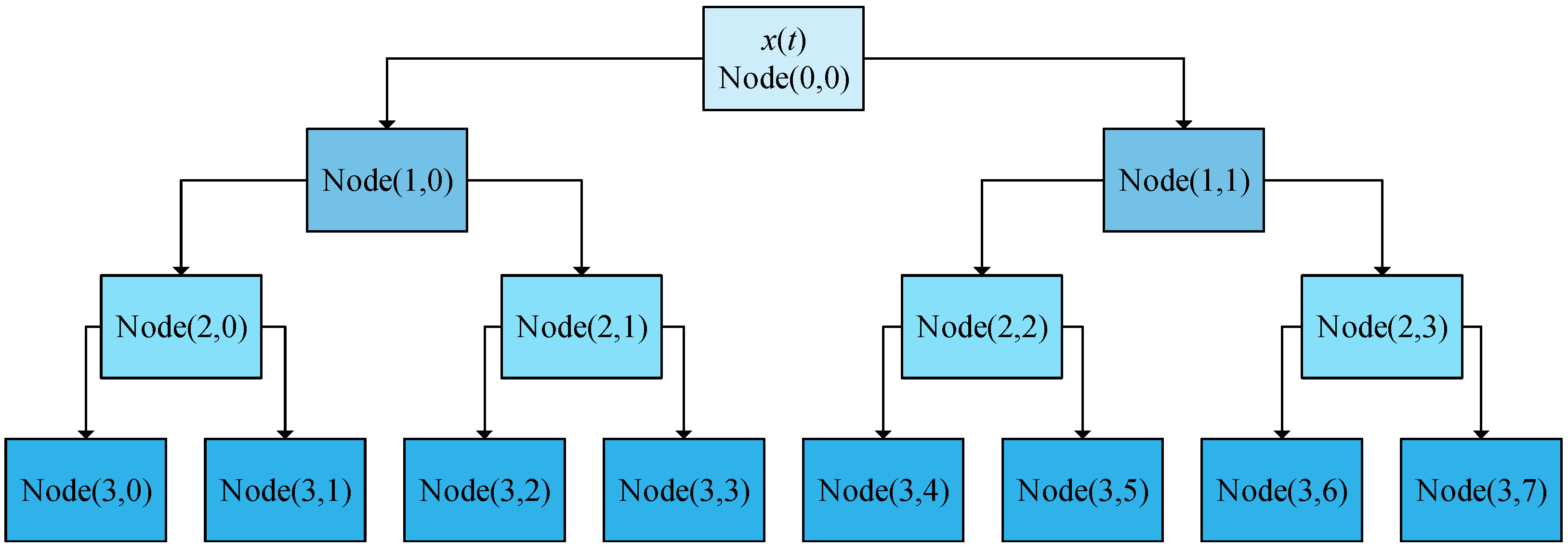
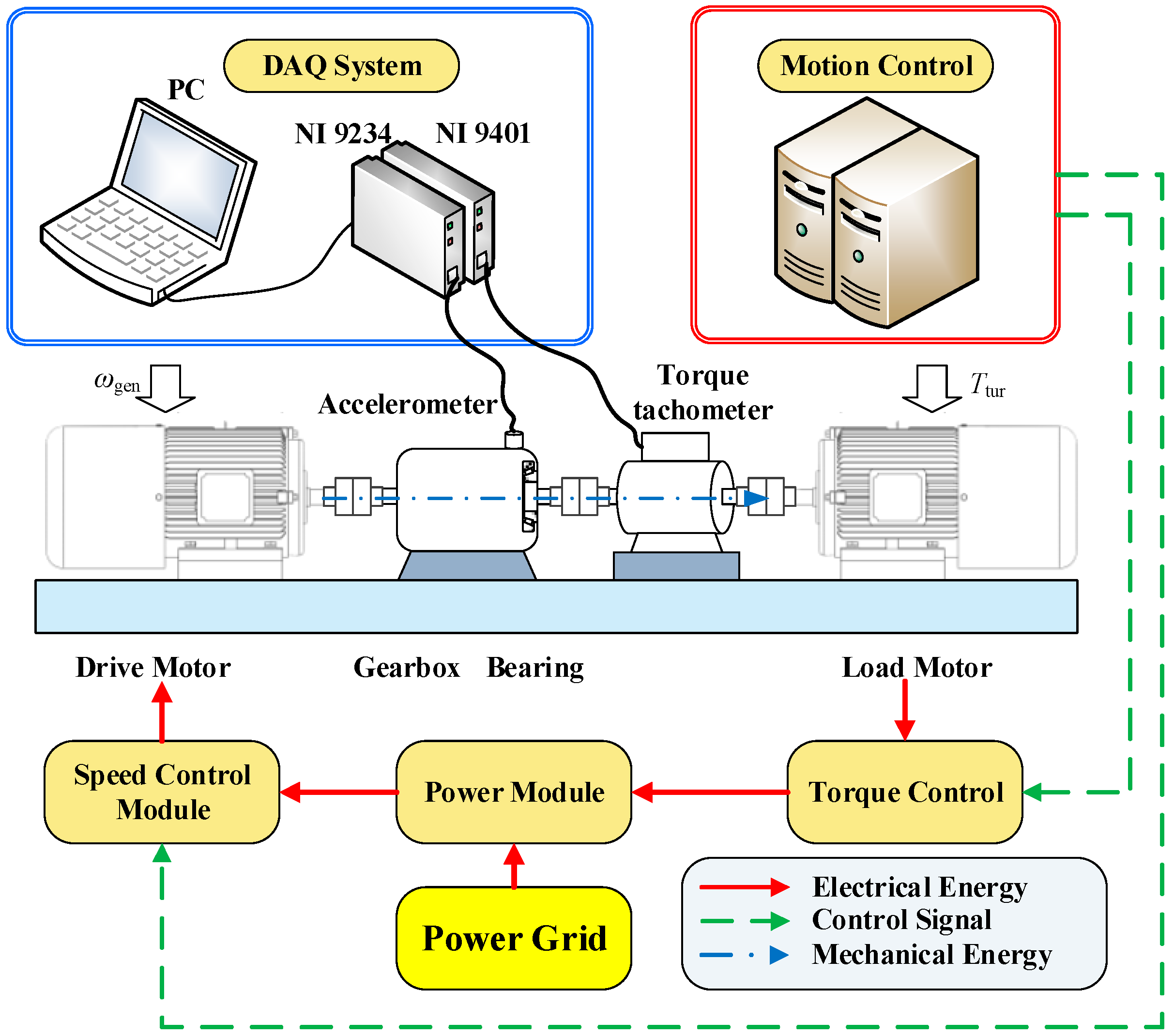
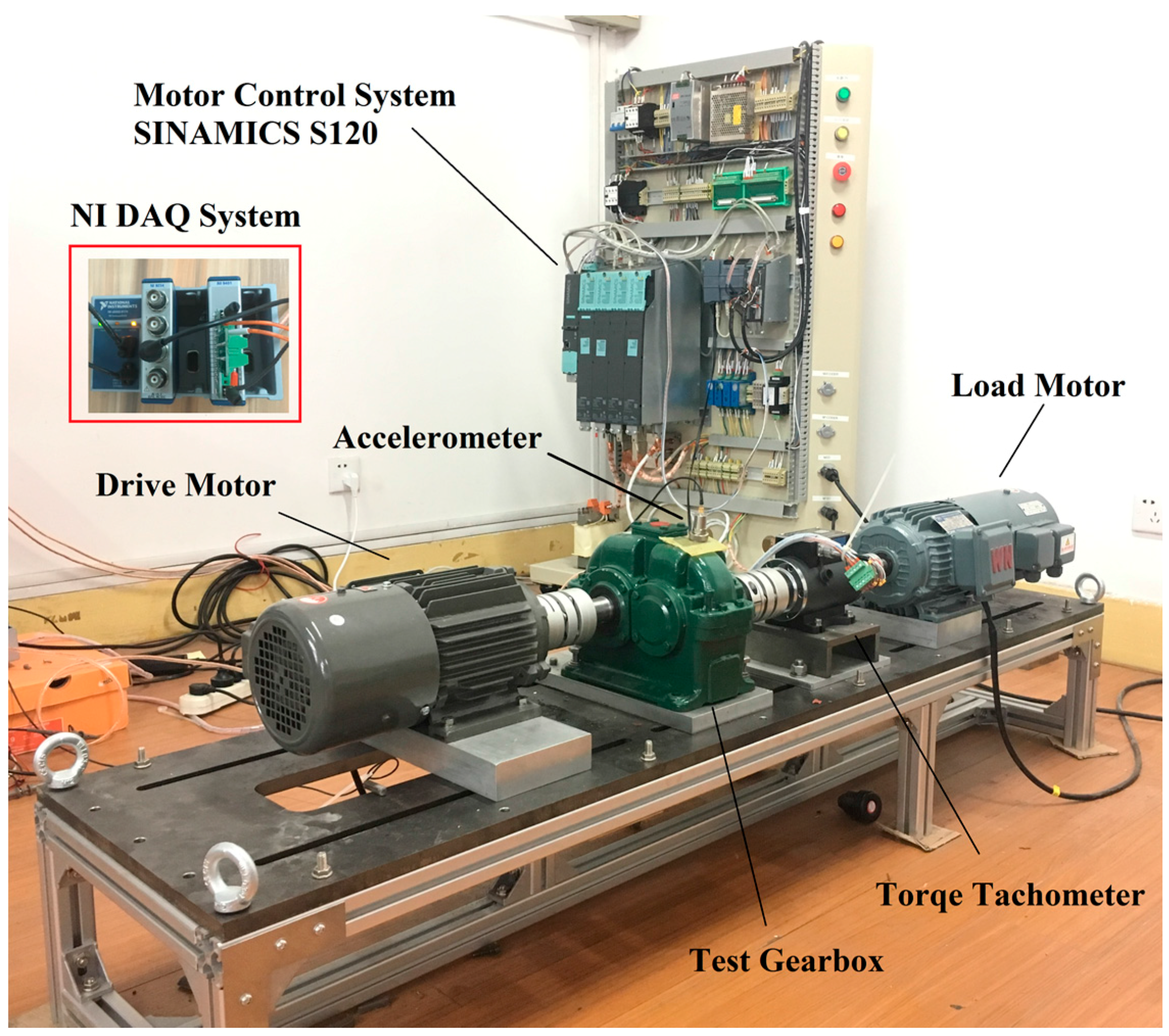
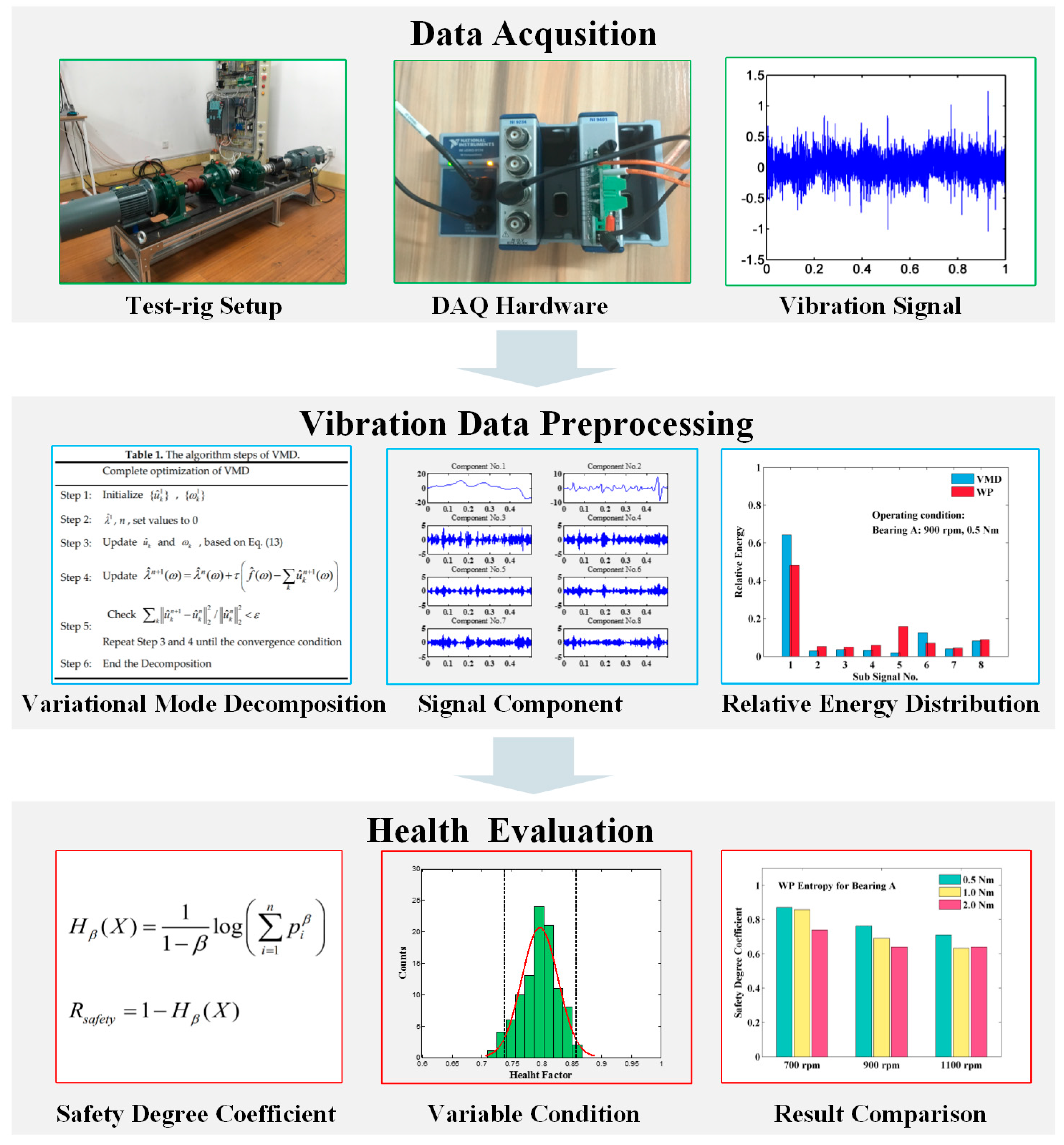
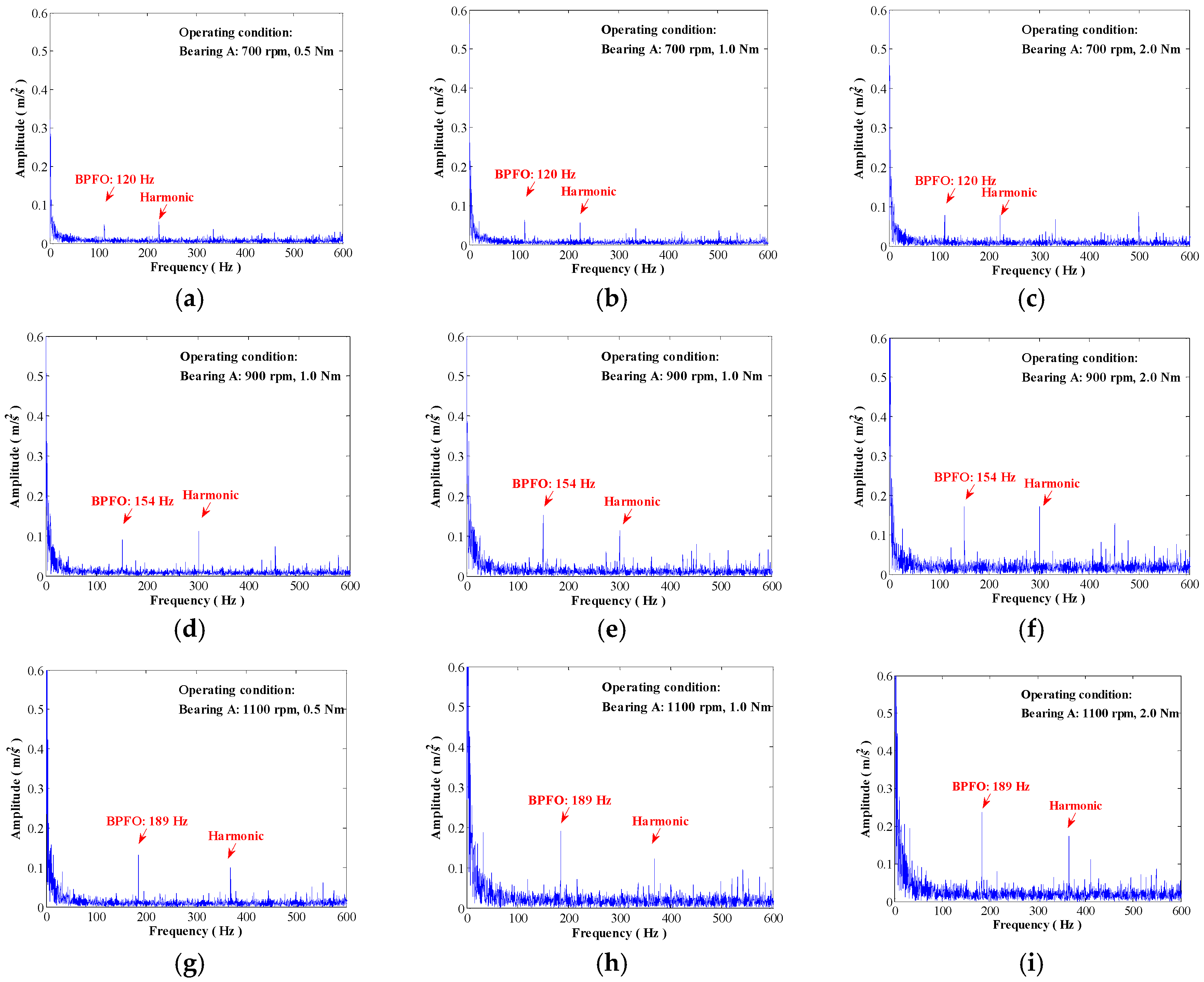

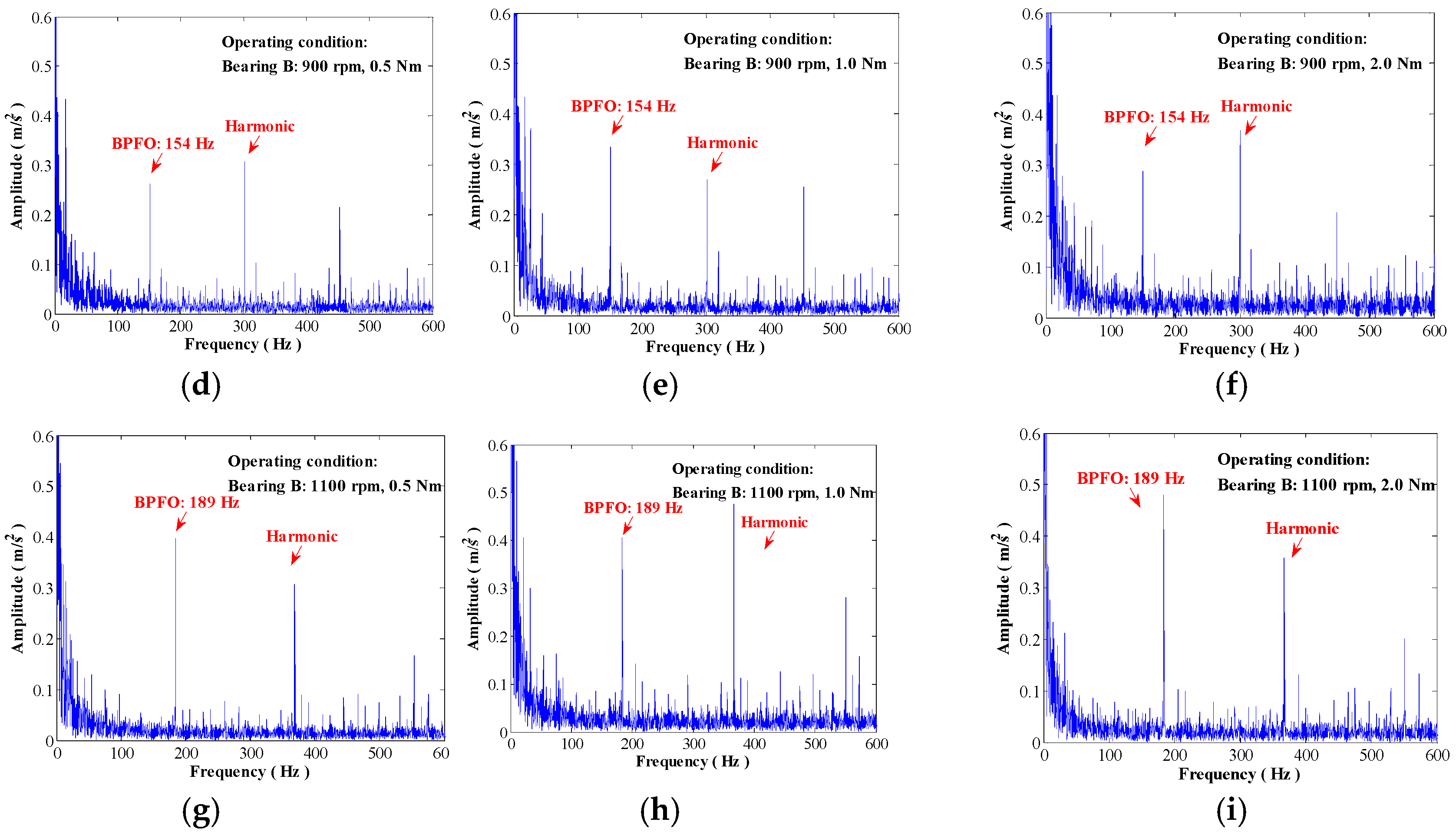
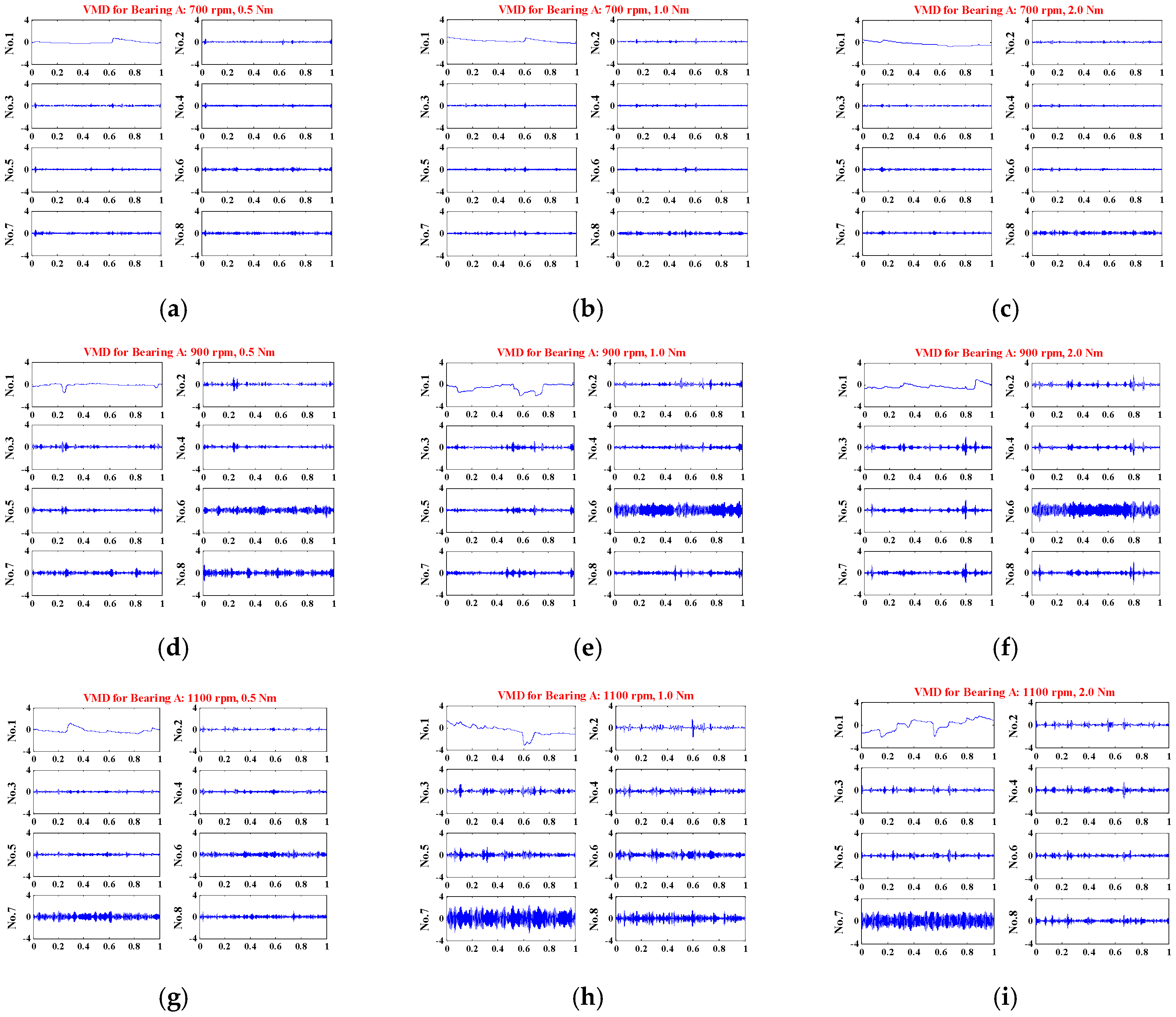
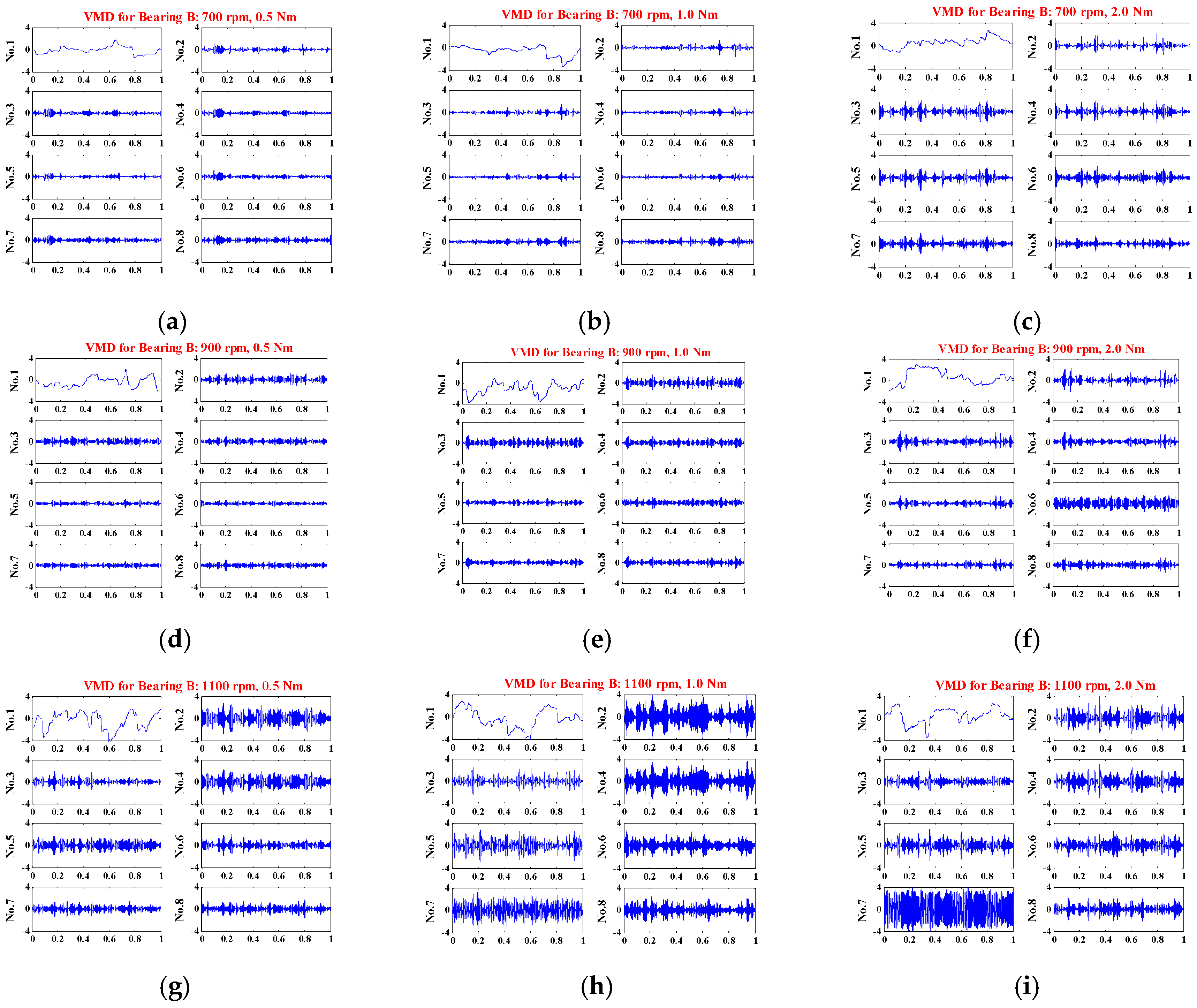
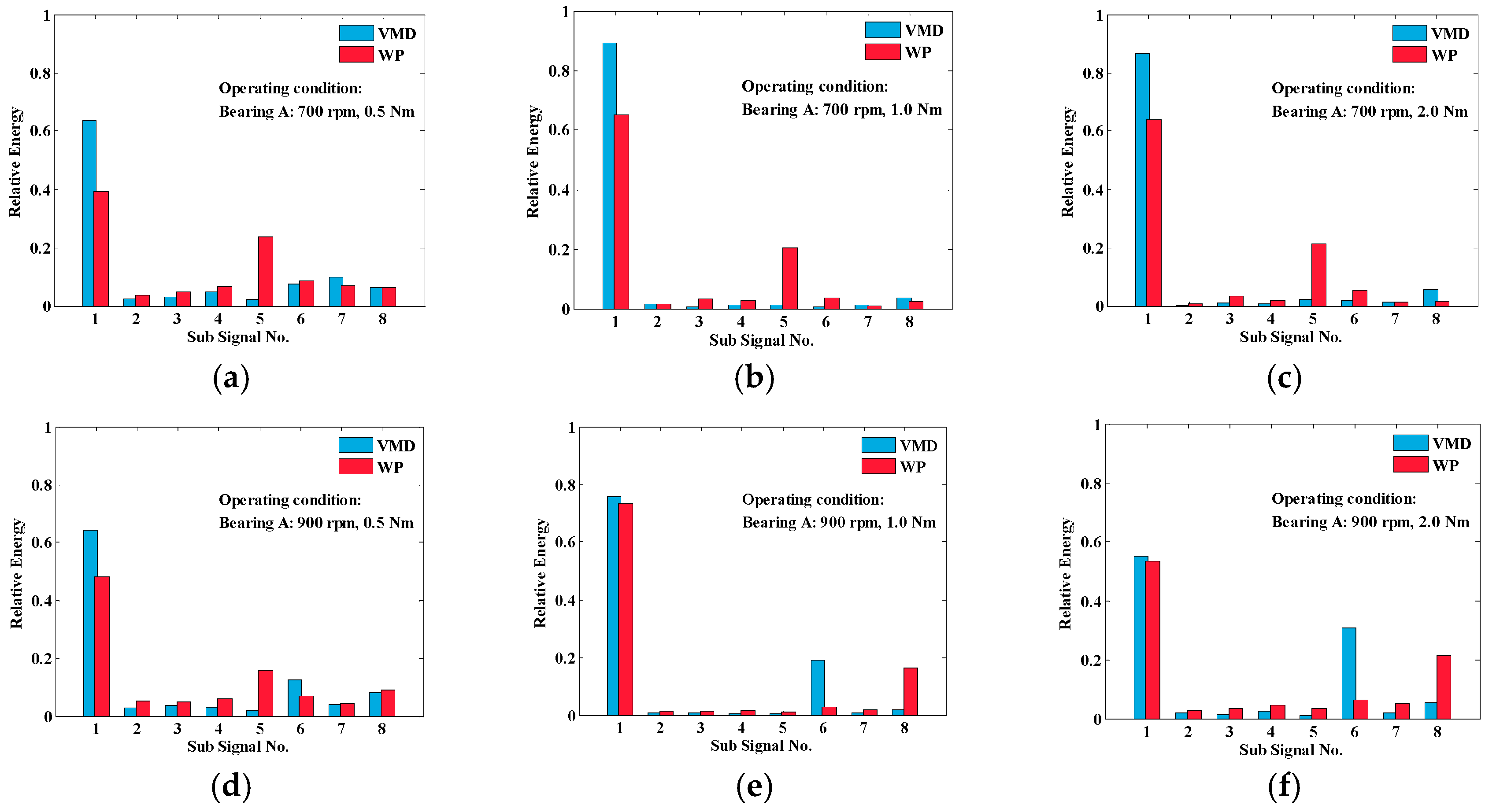


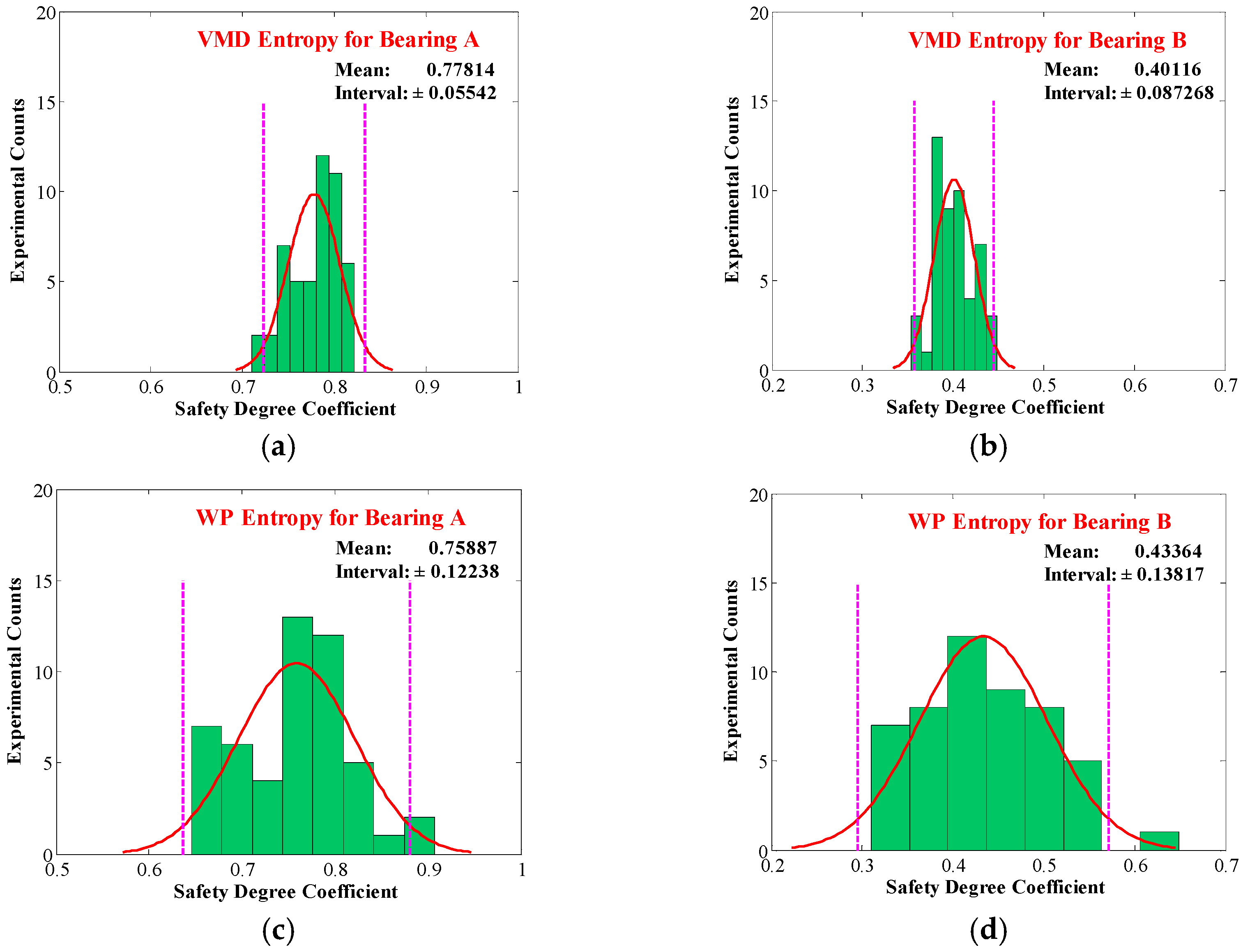
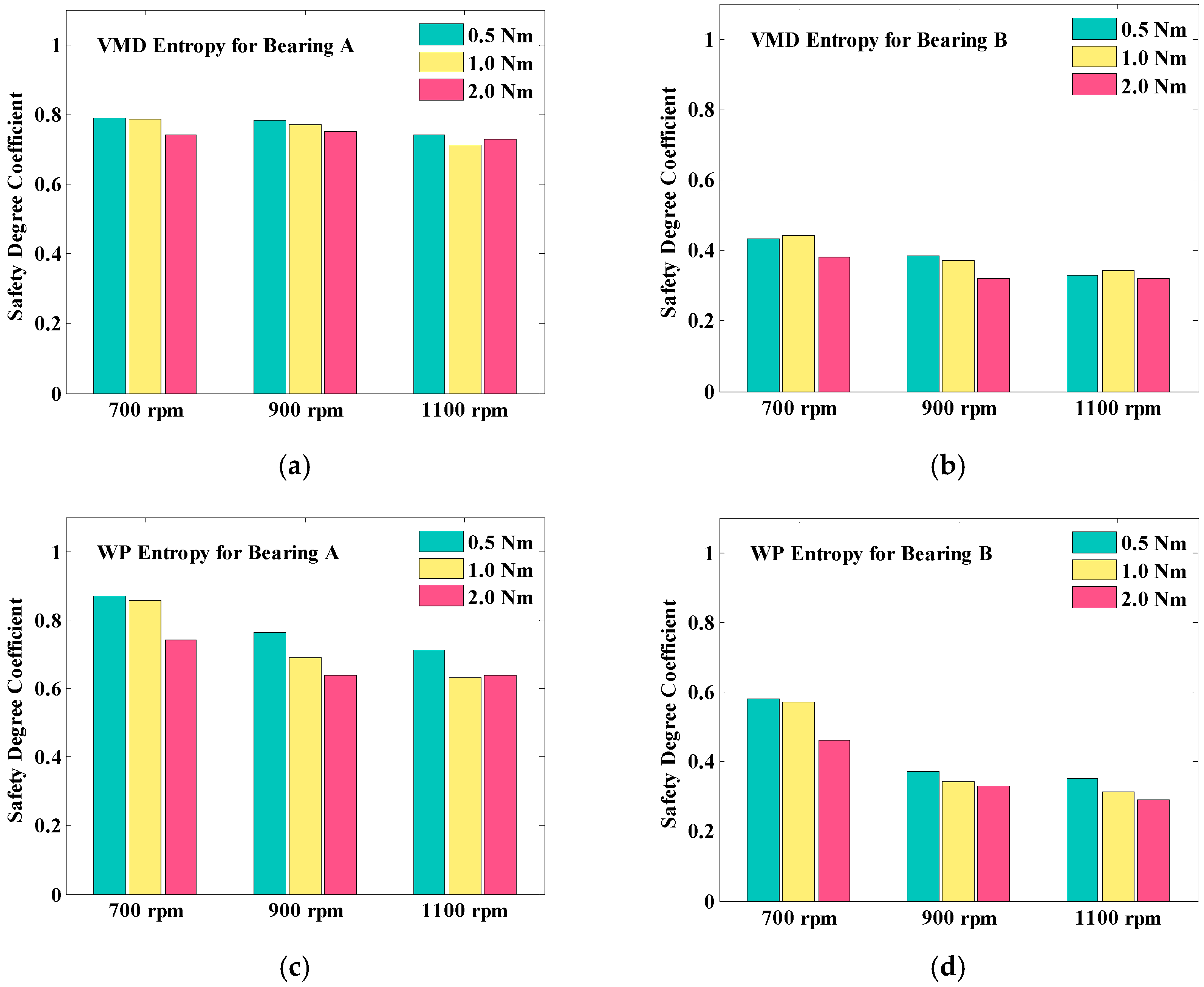
| Step Order | Complete Optimization of VMD |
|---|---|
| Step 1: | Initialize , |
| Step 2: | , n, set values to 0 |
| Step 3: | Update and , based on Equation (13) |
| Step 4: | Update |
| Step 5: | Check Repeat Steps 3 and 4 until the convergence condition |
| Step 6: | End the Decomposition |
| Setting Operating Condition | Defect Frequency | |
|---|---|---|
| Input Axis Speed | Load Torque | |
| 700 rpm | 0.5 Nm | 120.1 Hz |
| 1.0 Nm | ||
| 2.0 Nm | ||
| 900 rpm | 0.5 Nm | 154.4 Hz |
| 1.0 Nm | ||
| 2.0 Nm | ||
| 1100 rpm | 0.5 Nm | 188.7 Hz |
| 1.0 Nm | ||
| 2.0 Nm | ||
© 2017 by the authors. Licensee MDPI, Basel, Switzerland. This article is an open access article distributed under the terms and conditions of the Creative Commons Attribution (CC BY) license (http://creativecommons.org/licenses/by/4.0/).
Share and Cite
Fu, L.; Wei, Y.; Fang, S.; Zhou, X.; Lou, J. Condition Monitoring for Roller Bearings of Wind Turbines Based on Health Evaluation under Variable Operating States. Energies 2017, 10, 1564. https://doi.org/10.3390/en10101564
Fu L, Wei Y, Fang S, Zhou X, Lou J. Condition Monitoring for Roller Bearings of Wind Turbines Based on Health Evaluation under Variable Operating States. Energies. 2017; 10(10):1564. https://doi.org/10.3390/en10101564
Chicago/Turabian StyleFu, Lei, Yanding Wei, Sheng Fang, Xiaojun Zhou, and Junqiang Lou. 2017. "Condition Monitoring for Roller Bearings of Wind Turbines Based on Health Evaluation under Variable Operating States" Energies 10, no. 10: 1564. https://doi.org/10.3390/en10101564





